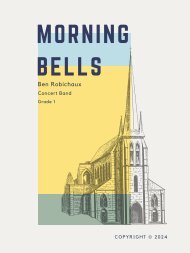Create successful ePaper yourself
Turn your PDF publications into a flip-book with our unique Google optimized e-Paper software.
SUGGESTED INSTRUMENTATION<br />
The following list has been provided below to serve as a guide for your part assignments; any combination of these instruments at<br />
your discretion can be used to perform this work, as long as they each fulfill the number of parts required. As few as six players, one<br />
per part, can perform this work.<br />
If you're able to do this, don't be afraid to experiment with different instrumental combinations when performing this work! These<br />
experimentations can be used a learning tool for you and your performers for how color and texture can change with even the<br />
smallest difference in orchestration (example: have the flutes play alone at a particular passage, then clarinets and/or saxophones,<br />
then a combination of all of these families. What are the differences in timbre? Does it affect the mood or emotion of the piece, and if<br />
so, how?). Use this piece, in that regard, as an endless sea of experimentation and creative possibilities for you and your performers.<br />
With all of this in mind, this arrangement of TO RIGHT OUR WRONGS should be used as opportunity to demonstrate how music<br />
isn't just chord progressions, electronic samples, heavy-metal grooves, or even just simply dots on a page. It's how that music is<br />
brought to life with what we have available; what we can create from it; how decisions of musical intent, listening to each other, and<br />
hearing these new sounds/colors/textures can impact musical intent for a piece of music and/or our perceptions of it; and finally,<br />
how we can use these skills for any performance situation, no matter what the instrumentation, style, or genre may be.<br />
PART I<br />
Piccolo, Flute/Oboe<br />
Eb Clarinet<br />
Bb Clarinet, Soprano Sax<br />
PART II<br />
Flute/Oboe, C Trumpet<br />
Bb Clarinet, Soprano Sax, Bb Trumpet<br />
Eb Alto Sax<br />
PART III<br />
Flute/Oboe, C Trumpet<br />
Bb Clarinet, Bb Trumpet<br />
Eb Alto Sax<br />
English Horn, Horn (F)<br />
PART IV<br />
C Trumpet<br />
Bassoon, Trombone, Euphonium (B.C.)<br />
Bb Clarinet, Bb Trumpet<br />
Bass Clarinet, Tenor Sax, Euphonium (T.C.)<br />
Eb Alto Sax<br />
English Horn, Horn (F)<br />
PART V<br />
Bassoon, Trombone, Euphonium (B.C.)<br />
Bass Clarinet, Tenor Sax, Euphonium (T.C.)<br />
Eb Baritone Sax<br />
PART VI<br />
Bassoon/Contrabassoon, Trombone, Euphonium (B.C.)<br />
Bass Trombone, Tuba<br />
Bass/Contrabass Clarinet, Tenor/Bass Sax, Euphonium (T.C.)<br />
Eb Baritone Sax<br />
All parts listed here are entirely optional, and are not necessary for the success of this work.<br />
Piano<br />
Keyboard Synthesizer 1+2<br />
CHOIR (see Performance Notes for more details):<br />
Soprano<br />
Alto<br />
Baritone (younger voices)<br />
Tenor (older voices)<br />
Bass (older voices)<br />
ADDITIONAL PARTS<br />
A vocal <strong>score</strong> has been provided for rehearsal purposes only.<br />
PERCUSSION LIST<br />
While all percussion is entirely optional for the sake of practicality, it is strongly recommended<br />
that as many of these parts as possible be assigned in order to fulfill the original intentions of this work.<br />
Timpani (4 drums recommended; 5 drums may be used if necessary and available)<br />
Chimes<br />
Suspended Cymbal (mallets and sticks required; see Performance Notes)<br />
China Cymbal (mallets and sticks required; see Performance Notes)<br />
Snare Drum<br />
Bass Drum

















